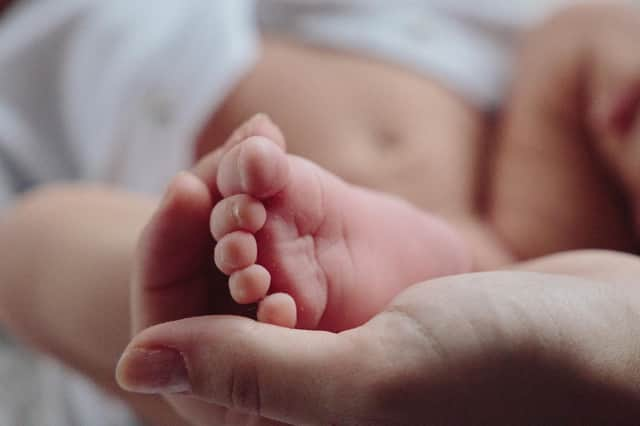Healthcare inspectors find maternity services at Leicester hospital do not keep women and babies safe


Maternity services at Leicester hospitals do not have enough staff to keep women and their babies safe, inspectors have warned.
Healthcare watchdog The Care Quality Commission (CQC) said a recent inspection found a ‘deterioration in the level of care’ being provided to those using maternity services at Leicester General Hospital and Leicester Royal Infirmary (LRI).
Advertisement
Hide AdAdvertisement
Hide AdBoth hospitals saw their rating for maternity care drop from ‘good’ to ‘requires improvement’.
A notice has been issued to the University Hospitals of Leicester NHS Trust (UHL), which is responsible for running the city’s hospitals, warning it ‘to focus the trust’s attention on rapidly making the necessary improvements’.
Many expectant mothers in Harborough district travel to Leicester General or LRI for maternity care.
Julie Hogg, chief nurse for the University Hospitals of Leicester NHS Trust, said steps had already been taken to recruit more staff and improving maternity services was a key priority.
Advertisement
Hide AdAdvertisement
Hide AdThe CQC says maternity services at both LRI and the General were ‘regularly understaffed’ placing ‘people and their babies at risk’. It also meant staff could not always take their breaks, which ‘affected well-being, morale and ability to do their job’.
Carolyn Jenkinson, CQC deputy director of secondary and specialist healthcare, said: “We found multiple examples where people’s care had been delayed in maternity triage due to doctors not being available. Some of these delays were very long, for example six hours, and some resulted in people self-discharging before they had a medical review, which could place them at risk.”
Staff at the General told inspectors the service ‘had been very short-staffed’, which had been ‘really hard work’ and staff were ‘pushed to the brink’. They told inspectors there used to be up to 15 midwives on the delivery suite, but now there could be as few as seven.
In the six months between August 2022 and January this year, 834 midwifery ‘red flags’ had been reported for the General and 1,002 at LRI. A red flag is a warning sign something may be wrong with midwifery staffing.
Advertisement
Hide AdAdvertisement
Hide AdStaff at LRI told inspectors induced labour was sometimes paused because of staff shortages, and women were given the option of going home. Delays were also attributed to bed capacity and how busy the service was, according to the CQC report.
Managers at LRI also raised concerns about staffing on antenatal and postnatal wards, and triage staffing was flagged as a concern by inspectors at both hospitals.
At LRI, there were supposed to be three members of staff on triage, two midwives and a maternity care assistant. There should also be a triage midwife for people calling for help.
But there was not always a maternity care assistant or phone triage midwife. There could be as many as 30 women in the triage area with just two midwives to care for them and cover the phones, the report said.
Advertisement
Hide AdAdvertisement
Hide AdJunior doctors in their first year or second also sometimes had to cover consultants when there were not enough to cover all areas of care. The report on the General said junior doctors were ‘used interchangeably with more experienced doctors as though they were equivalent’.
Planned births were being delayed in some cases when an emergency case came into the hospital. Between November 2022 and February 2023, there were 76 delayed or postponed caesareans.
UHL said there were plans to open a second theatre at the General. There is also a plan to open a third theatre at the LRI, where maternity staff sometimes had to use the recovery area as their third theatre when there were more than two emergencies at the same time.
The inspection team also found out-of-date milk, liquid medicines without dates for when they were opened or expired, and medicine strips without boxes. Some patient breast milk was named, but did not have patient numbers on them, the report added. This created a risk of mix ups if two patients had the same name, inspectors said.
Advertisement
Hide AdAdvertisement
Hide AdClinical equipment such as foetal heart detectors, incubators, blood pressure monitors and resuscitators were not always serviced as often as they should be, and the report added that areas of the hospitals were ‘visibly dirty’.
The CQC noted that the leadership of maternity services had recently changed.
Ms Jenkinson said: “Senior leaders already had plans in place to prioritise the main risks, including staffing levels, so we hope to see these changes when we next inspect. Staff spoke positively about the new leadership team, describing them as visible and approachable and felt they supported staff to develop their skills and take on more senior roles.
“In addition, a matron had recently been appointed to focus solely on recruitment, retention and staff wellbeing.”
Advertisement
Hide AdAdvertisement
Hide AdChief nurse at University Hospitals of Leicester NHS Trust Julie Hogg said: “Improving maternity services is a key priority and many of the highlighted challenges had already been identified before the inspection, with plans in place to tackle them. However, we take the report and its findings incredibly seriously and are using them to drive further improvements for women and birthing people.
“Our new director of midwifery has overseen plans to strengthen staffing. Since January this year, 25 new midwives have joined us, and we will welcome 24 more in November. We have invested in new equipment and daily safety checking and made rapid improvements to cleanliness and infection prevention practices. We are also progressing plans for a new maternity theatre at the Leicester General Hospital, meaning that planned and emergency caesareans will take place in separate areas.
“While we know there is more to do, we are committed to providing safe, high-quality and compassionate care and are encouraged the reports highlight our hardworking staff and the actions being taken to ensure a culture of safety and openness.”